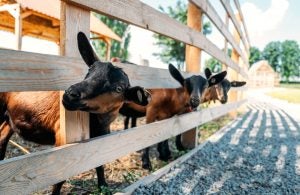If you’ve had livestock or poultry for any amount of time you know the feeling — the one where you realize that your animals are under some kind of attack. The feeling when you realize that, somewhere, there was a weakness in the fencing; one of your chickens didn’t go back in the coop before it got dark; there was some fault in the design of your coop or barn and something has gotten into it.
It doesn’t matter if the livestock or poultry are your pets or part of your business … you feel the responsibility in every scenario.
In these instances, the best thing to do is to prevent the attack in the first place. There are all kinds of effective fencing, like hog or cattle panels or electric and wire fencing. There are all kinds of guard animals, like llamas or livestock guardian dogs (referred to as LGDs). Figure out what works for your operation.
At one point I had a llama, Bruce, who was absolutely a deterrent, but he became increasingly aggressive toward me. Our journey together culminated in a boxing match in my small pasture that ended with me desperately needing a shower and him desperately needing a new pasture. But that’s a story for another time.
While LGDs are great in most instances, dogs that are not a part of your “farm family” can often pose a danger to your livelihood. A 2011 report by the National Agricultural Statistics Service reported that nearly 10 percent of cattle deaths in the U.S. were caused by dogs.
In 2020 alone, I had three dog attacks on my farm. I lost three goats, 14 ducks, a gosling, and five chickens. The first time, two dogs chewed through three layers of field fence to get into my barn and terrorized my goats for hours. After trapping them in a pasture, they escaped through the hog panels and chased down nine ducks. My 4.5-acre farm was a warzone.
The second and third attacks were by a different dog. The owner couldn’t imagine how the dog could do so much damage in such a small amount of time … twice. Educating our neighbors, our community, and our farm customers goes a long way toward preventing these situations.

Unless they run a working farm, folks generally have no clue of the value of farm animals. They don’t understand the position a farmer is put in when they lose a milk goat or a laying hen (or several). The general public is disconnected from their local food systems; it’s difficult for them to have a concept of the value of farm animals.
The most effective way that we, as farmers, can protect our livestock and poultry from domestic animal predation is through education.
Connecting non-farmers to their local food systems will help them understand the value of even one single chicken to a working farm. So, when their dogs kill a farmer’s animals, they will have an idea of what that means to the farmer. On the flip side it’s important that, as a farmer, you know what your rights are. If you witness the attack, what can you do? It varies from city to city, county to county, and even state to state. Where I live, I know if I catch a dog actively attacking one of my animals, I have the right to shoot the dog. If I only see the damage and the dog is no longer attacking the animals, I no longer have that right. In my county, after animal control launches an investigation and/or takes possession of the offending animals, the only recourse is to take the owner to small claims court to try to recoup at least some of the value of the animals. Do your research and know your rights!
What makes this kind of attack the worst is that domesticated dogs don’t kill animals for survival. It’s a needless death for no other reason than it’s fun for the dog. Its owner has seriously misjudged their animal and not taken necessary precautions. If it’s a wild predator, the animal is eaten and re-enters the farm’s ecosystem, even if it’s sad to lose an animal.
We could talk all day about fencing, livestock guardians, and secured barns. My call to action here is two-fold:
- First, connecting consumers to their local food systems gives them an understanding of the value of the animals raised by their local farmers. The hope here is that this knowledge will prompt responsible handling of animals unfamiliar with a more agrarian setting.
- Second, know your rights. Know what you can do during and after a domestic animal attack. Call animal control and ask. Look up precedent-setting legal cases. Find local ordinances. Know what your rights are.
Farm on.
Brianna Scott is a veteran farmer who lives in Eastern Washington while earning her Master’s of Science in Agriculture from Washington State University. She is active in the veteran ag community and raises poultry and livestock while growing a large market garden.



